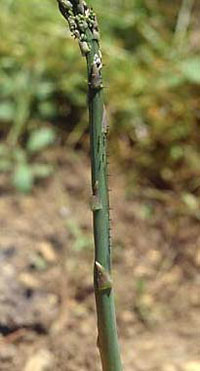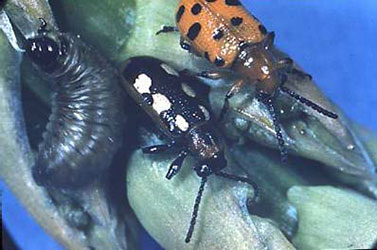Fact Sheet FS221
Injury
Asparagus beetle adults feed on young shoots during the harvest season, chew holes in the shoots, and lay small, dark brown eggs standing on end on the spears. Shoots often become curved and irregular in shape due to beetle feeding. Larvae of the common asparagus beetle appear in spring and in fall, gnaw stems and leaves, and can virtually defoliate and severely weaken plants. Larvae of the spotted asparagus beetle usually appear just prior to or during berry formation, bore into developing berries, and eat pulp and seeds; spotted asparagus beetle larva can destroy three to four berries each before pupating in the soil. Damage to the plant in the fall weakens the plant, resulting in plants that produce poor yields the following spring. The damage also makes the plants more susceptible to disease.
Description and Life History
The common asparagus beetle, Crioceris asparagi (Linnaeus), is ¼ inch long, slender, and blue-black in color with three, yellowish-white squares on each wing cover. Its larvae are dark gray and slug-like, and can be found feeding on the foliage. The spotted asparagus beetle, Crioceris duodecimpunctata (Linnaeus), is slightly larger, reddish to orange in color, with six prominent black spots on each wing cover. Its larvae are grayish-orange and slug-like, and feed only within the berries. Larvae of both species drop to the ground to pupate in the soil. Adult asparagus beetles overwinter in sheltered places, old fence posts, logs, etc. In New Jersey each species has two generations per year.
Management of Asparagus Beetles
- Beetles and larvae are easy to hand-pick and destroy. Larvae are often found clumped together, and branches with larvae on them can be shaken over a can to dislodge the larvae, or branches with the larvae can be removed.
- Harvest asparagus daily to reduce adult beetle damage to the shoots.
- Cultivate and fertilize properly to encourage rapid spring growth, thereby leaving less time for beetles to damage shoots.
- Grow asparagus a safe distance from places suitable for beetle hibernation.
- Collect and destroy berries for spotted asparagus beetle control. Or, an alternative is to plant only male-hybrid varieties, which have no berries and will eliminate fall populations of the spotted asparagus beetles.
- Lady beetle larvae feed on small larvae and will help keep them under control.
- Feeding by the beetles on the young shoots in spring is difficult to prevent. During the harvest season, frequent spraying may be necessary to prevent chewing damage and egg deposition if beetles are abundant. Direct insecticide sprays at the emerging shoots.
- During summer and early fall, treatments can be applied to the ferns to control both asparagus beetle larvae and adults. Beetle control at this time will reduce the number of adults going into hibernation, thereby reducing emergence and thus damage to shoots the following spring.
- If pesticides are used, read and follow all pesticide label directions, restrictions, and precautionary statements.
March 2005
Copyright © 2024 Rutgers, The State University of New Jersey. All rights reserved.
For more information: njaes.rutgers.edu.
Cooperating Agencies: Rutgers, The State University of New Jersey, U.S. Department of Agriculture, and Boards of County Commissioners. Rutgers Cooperative Extension, a unit of the Rutgers New Jersey Agricultural Experiment Station, is an equal opportunity program provider and employer.




